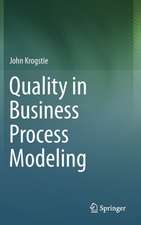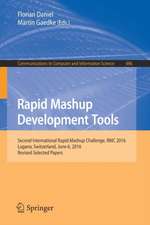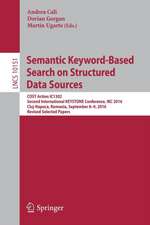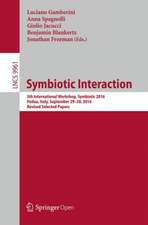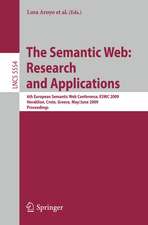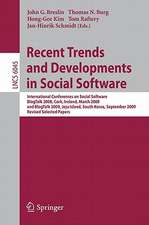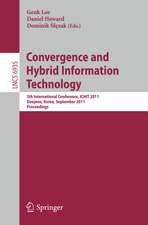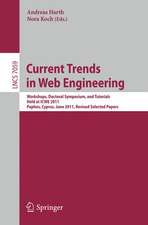Context and Semantics for Knowledge Management: Technologies for Personal Productivity
Editat de Paul Warren, John Davies, Elena Simperlen Limba Engleză Paperback – 8 oct 2014
The work described in this book is motivated by the need to increase the productivity of knowledge work. Based on results from the EU-funded ACTIVE project and complemented by recent related results from other researchers, the application of three approaches is presented: the synergy of Web 2.0 and semantic technology; context-based information delivery; and the use of technology to support informal user processes. The contributions are organized in five parts. Part I comprises a general introduction and a description of the opportunities and challenges faced by organizations in exploiting Web 2.0 capabilities. Part II looks at the technologies, and also some methodologies, developed in ACTIVE. Part III describes how these technologies have been evaluated in three case studies within the project. Part IV starts with a chapter describing the principal market trends for knowledge management solutions, and then includes a number of chapters describing work complementary to ACTIVE. Finally, Part V draws conclusions and indicates further areas for research.
Overall, this book mainly aims at researchers in academia and industry looking for a state-of-the-art overview of the use of semantic and Web 2.0 technologies for knowledge management and personal productivity. Practitioners in industry will also benefit, in particular from the case studies which highlight cutting-edge applications in these fields.
| Toate formatele și edițiile | Preț | Express |
|---|---|---|
| Paperback (1) | 648.26 lei 6-8 săpt. | |
| Springer Berlin, Heidelberg – 8 oct 2014 | 648.26 lei 6-8 săpt. | |
| Hardback (1) | 653.21 lei 6-8 săpt. | |
| Springer Berlin, Heidelberg – 15 sep 2011 | 653.21 lei 6-8 săpt. |
Preț: 648.26 lei
Preț vechi: 810.33 lei
-20% Nou
Puncte Express: 972
Preț estimativ în valută:
124.04€ • 129.98$ • 102.54£
124.04€ • 129.98$ • 102.54£
Carte tipărită la comandă
Livrare economică 12-26 aprilie
Preluare comenzi: 021 569.72.76
Specificații
ISBN-13: 9783642434181
ISBN-10: 3642434185
Pagini: 352
Ilustrații: XIV, 337 p.
Dimensiuni: 155 x 235 x 18 mm
Greutate: 0.49 kg
Ediția:2011
Editura: Springer Berlin, Heidelberg
Colecția Springer
Locul publicării:Berlin, Heidelberg, Germany
ISBN-10: 3642434185
Pagini: 352
Ilustrații: XIV, 337 p.
Dimensiuni: 155 x 235 x 18 mm
Greutate: 0.49 kg
Ediția:2011
Editura: Springer Berlin, Heidelberg
Colecția Springer
Locul publicării:Berlin, Heidelberg, Germany
Public țintă
ResearchCuprins
Part I – Addressing the challenges of knowledge work.- Introduction.- Web 2.0 and network intelligence.- Part II – ACTIVE technologies and methodologies.- Enterprise knowledge structures.- Using cost-benefit information in ontology engineering projects.- Managing and understanding context.- Machine learning techniques for understanding context and process.- Part III – Applying and validating the ACTIVE technologies.- Increasing productivity in the customer-facing environment.- Machine learning and lightweight semantics to improve enterprise search and knowledge management.- Increasing predictability and sharing tacit knowledge in electronic design.- Part IV – Complementary activities.- Some market trends for knowledge management solutions.- Applications of semantic wikis.- The NEPOMUK semantic desktop.- Context-aware recommendation for work-integrated learning.- Evolving metaphors for managing and interacting with digital information.- Part V – Conclusions.- Conclusions.
Notă biografică
Paul Warren
During 2008 to early 2011 Paul Warren was Project Director for the ACTIVE project. Immediately prior to ACTIVE Paul worked for BT in the areas of knowledge management, semantic technologies and service oriented computing. At an earlier stage in his career, Paul worked on technology strategy and technology foresight, investigating areas as diverse as eBusiness and novel forms of computing. Paul has published widely on knowledge management, semantic technologies, and technology foresight. Besides this book, he has co-edited two books on topics related to ICT. Paul holds a degree in Theoretical Physics from Cambridge University and a M.Sc. in Electronics from Southampton University.
John Davies
John Davies is Chief Scientist in BT’s ICT Research Practice. He holds a PhD in computer science from the University of Essex. His interests include the application of semantic and Web 2.0 technologies to business intelligence, information integration, service-oriented environments and knowledge management. John has written and edited many papers and books on semantic technology and its applications, web-based information management and knowledge management. He was Project Coordinator of the SEKT and ACTIVE European research projects. Currently chairman of the European Semantic Technology Conference, he has served on the program committees of many conferences in related areas and was co-founder of the ESWC conference series. John is a Fellow of the British Computer Society and a Chartered Engineer.
Elena Simperl
Elena Simperl works as assistant professor at the Institute of Applied Informatics and Formal Description Methods (AIFB) at the Karlsruhe Institute of Technology (KIT). She hold a PhD in Computer Science from the Free University of Berlin and a Diploma in Computer Science from the Technical University of Munich. She has held research and teaching positions at the TechnicalUniversity of Munich (2002-2003), the Free University of Berlin (2003-2007), and the Semantic Technology Institute (STI) Innsbruck at the University of Innsbruck, Austria (2007-2009) before joining KIT in January 2010. Elena's primary domain of research is semantic technologies. She has been working as a Semantic Web researcher for almost a decade, being involved in over 15 European and national projects in this field, authoring over 75 publications, and serving as chair to several relevant academic conferences and workshops.
During 2008 to early 2011 Paul Warren was Project Director for the ACTIVE project. Immediately prior to ACTIVE Paul worked for BT in the areas of knowledge management, semantic technologies and service oriented computing. At an earlier stage in his career, Paul worked on technology strategy and technology foresight, investigating areas as diverse as eBusiness and novel forms of computing. Paul has published widely on knowledge management, semantic technologies, and technology foresight. Besides this book, he has co-edited two books on topics related to ICT. Paul holds a degree in Theoretical Physics from Cambridge University and a M.Sc. in Electronics from Southampton University.
John Davies
John Davies is Chief Scientist in BT’s ICT Research Practice. He holds a PhD in computer science from the University of Essex. His interests include the application of semantic and Web 2.0 technologies to business intelligence, information integration, service-oriented environments and knowledge management. John has written and edited many papers and books on semantic technology and its applications, web-based information management and knowledge management. He was Project Coordinator of the SEKT and ACTIVE European research projects. Currently chairman of the European Semantic Technology Conference, he has served on the program committees of many conferences in related areas and was co-founder of the ESWC conference series. John is a Fellow of the British Computer Society and a Chartered Engineer.
Elena Simperl
Elena Simperl works as assistant professor at the Institute of Applied Informatics and Formal Description Methods (AIFB) at the Karlsruhe Institute of Technology (KIT). She hold a PhD in Computer Science from the Free University of Berlin and a Diploma in Computer Science from the Technical University of Munich. She has held research and teaching positions at the TechnicalUniversity of Munich (2002-2003), the Free University of Berlin (2003-2007), and the Semantic Technology Institute (STI) Innsbruck at the University of Innsbruck, Austria (2007-2009) before joining KIT in January 2010. Elena's primary domain of research is semantic technologies. She has been working as a Semantic Web researcher for almost a decade, being involved in over 15 European and national projects in this field, authoring over 75 publications, and serving as chair to several relevant academic conferences and workshops.
Textul de pe ultima copertă
Knowledge and information are among the biggest assets of enterprises and organizations. However, efficiently managing, maintaining, accessing, and reusing this intangible treasure is difficult. Information overload makes it difficult to focus on the information that really matters; the fact that much corporate knowledge only resides in employees’ heads seriously hampers reuse.
The work described in this book is motivated by the need to increase the productivity of knowledge work. Based on results from the EU-funded ACTIVE project and complemented by recent related results from other researchers, the application of three approaches is presented: the synergy of Web 2.0 and semantic technology; context-based information delivery; and the use of technology to support informal user processes. The contributions are organized in five parts. Part I comprises a general introduction and a description of the opportunities and challenges faced by organizations in exploiting Web 2.0 capabilities. Part II looks at the technologies, and also some methodologies, developed in ACTIVE. Part III describes how these technologies have been evaluated in three case studies within the project. Part IV starts with a chapter describing the principal market trends for knowledge management solutions, and then includes a number of chapters describing work complementary to ACTIVE. Finally, Part V draws conclusions and indicates further areas for research.
Overall, this book mainly aims at researchers in academia and industry looking for a state-of-the-art overview of the use of semantic and Web 2.0 technologies for knowledge management and personal productivity. Practitioners in industry will also benefit, in particular from the case studies which highlight cutting-edge applications in these fields.
The work described in this book is motivated by the need to increase the productivity of knowledge work. Based on results from the EU-funded ACTIVE project and complemented by recent related results from other researchers, the application of three approaches is presented: the synergy of Web 2.0 and semantic technology; context-based information delivery; and the use of technology to support informal user processes. The contributions are organized in five parts. Part I comprises a general introduction and a description of the opportunities and challenges faced by organizations in exploiting Web 2.0 capabilities. Part II looks at the technologies, and also some methodologies, developed in ACTIVE. Part III describes how these technologies have been evaluated in three case studies within the project. Part IV starts with a chapter describing the principal market trends for knowledge management solutions, and then includes a number of chapters describing work complementary to ACTIVE. Finally, Part V draws conclusions and indicates further areas for research.
Overall, this book mainly aims at researchers in academia and industry looking for a state-of-the-art overview of the use of semantic and Web 2.0 technologies for knowledge management and personal productivity. Practitioners in industry will also benefit, in particular from the case studies which highlight cutting-edge applications in these fields.
Caracteristici
Presentation of up-to-date, Semantic-Web and Web-2.0-based technologies to enhance knowledge management in large organizations Illustration and validation of the technologies presented via several large industrial case studies Combination of academic rigor and novelty with industrial implementation and experiences Includes supplementary material: sn.pub/extras







